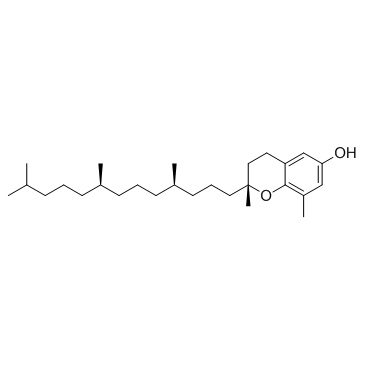(+)-Delta-Tocopherol

(+)-Delta-Tocopherol structure
|
Common Name | (+)-Delta-Tocopherol | ||
|---|---|---|---|---|
| CAS Number | 119-13-1 | Molecular Weight | 402.65300 | |
| Density | 0.935 g/cm3 | Boiling Point | 504.3ºC at 760 mmHg | |
| Molecular Formula | C27H46O2 | Melting Point | N/A | |
| MSDS | Chinese USA | Flash Point | 200.1ºC | |
|
Estimation of fruit and vegetable intake using a two-item dietary questionnaire: a potential tool for primary health care workers.
Nutr. Metab. Cardiovasc. Dis. 13(1) , 12-9, (2003) High fruit and vegetable intake is associated with health benefits for cancer and cardiovascular disease. An increase is therefore integral in recommendations for the prevention of chronic disease. However, measuring intake requires either extensive dietary a... |
|
|
Liquid chromatographic method for the determination of carotenoids, retinoids and tocopherols in human serum and in food.
J. Chromatogr. A. 619(1) , 37-48, (1993) A liquid chromatographic (LC) method has been developed for the quantitative measurement of the six major carotenoids in human serum (lutein, zeaxanthin, beta-cryptoxanthin, lycopene, alpha-carotene, and beta-carotene) as well as retinol, retinyl palmitate, a... |
|
|
Vitamin E isoform-specific inhibition of the exercise-induced heat shock protein 72 expression in humans.
J. Appl. Physiol. 100(5) , 1679-87, (2006) Increased levels of reactive oxygen and nitrogen species, as seen in response to exercise, challenge the cellular integrity. Important protective adaptive changes include induction of heat shock proteins (HSPs). We hypothesized that supplementation with antio... |
|
|
Mixed tocopherols inhibit platelet aggregation in humans: potential mechanisms.
Am. J. Clin. Nutr. 77(3) , 700-6, (2003) Epidemiologic studies have shown an inverse correlation between acute coronary events and high intake of dietary vitamin E. Recent clinical studies, however, failed to show any beneficial effects of alpha-tocopherol on cardiovascular events. Absence of tocoph... |
|
|
Combined lycopene and vitamin E treatment suppresses the growth of PC-346C human prostate cancer cells in nude mice.
J. Nutr. 136(5) , 1287-93, (2006) Epidemiologic studies have repeatedly associated a high intake of lycopene and vitamin E with reduced prostate cancer risk. The present study examined the ability of the 2 compounds to reduce tumor growth and prostate-specific antigen (PSA) plasma levels in t... |
|
|
Supplementation with mixed tocopherols increases serum and blood cell gamma-tocopherol but does not alter biomarkers of platelet activation in subjects with type 2 diabetes.
Am. J. Clin. Nutr. 83(1) , 95-102, (2006) Some studies have shown potential benefit of vitamin E on platelet function, but several clinical trials failed to show improved cardiovascular outcome with alpha-tocopherol supplementation. Gamma-tocopherol, a major dietary form of vitamin E, may have protec... |
|
|
Vitamin E: function and metabolism.
FASEB J. 13(10) , 1145-55, (1999) Although vitamin E has been known as an essential nutrient for reproduction since 1922, we are far from understanding the mechanisms of its physiological functions. Vitamin E is the term for a group of tocopherols and tocotrienols, of which alpha-tocopherol h... |
|
|
Tocotrienol: the natural vitamin E to defend the nervous system?
Ann. N. Y. Acad. Sci. 1031 , 127-42, (2004) Vitamin E is essential for normal neurological function. It is the major lipid-soluble, chain-breaking antioxidant in the body, protecting the integrity of membranes by inhibiting lipid peroxidation. Mostly on the basis of symptoms of primary vitamin E defici... |
|
|
gamma-Tocopherol or combinations of vitamin E forms induce cell death in human prostate cancer cells by interrupting sphingolipid synthesis.
Proc. Natl. Acad. Sci. U. S. A. 101(51) , 17825-30, (2004) gamma-Tocopherol (gammaT), the predominant form of vitamin E in diets, but not alpha-tocopherol, the major vitamin E form in tissues and supplements, inhibits proliferation of prostate cancer cells (LNCaP and PC-3) and lung cancer cells (A549). In contrast, a... |
|
|
Tocopherol distribution and intracellular localization in human adipose tissue.
Am. J. Clin. Nutr. 46(3) , 488-95, (1987) Adipocytes, isolated from human adipose tissue, were disrupted and then centrifuged, resulting in three fractions: oil, interface between the oil and the hypotonic buffer (containing lipid droplets surrounded by unilamellar membranes), and pelleted portion (c... |